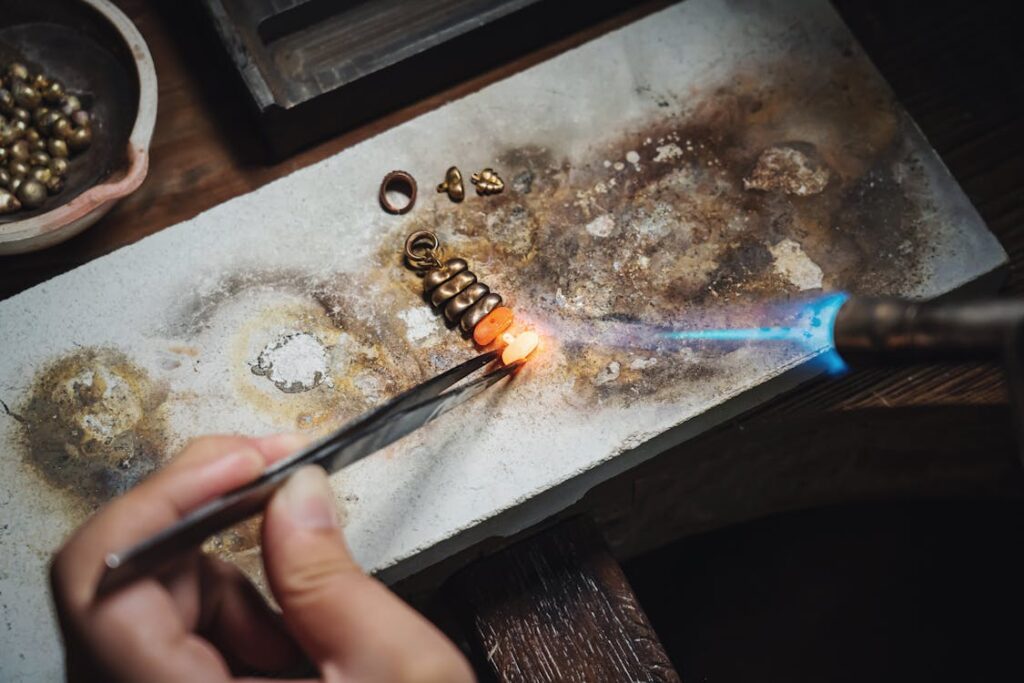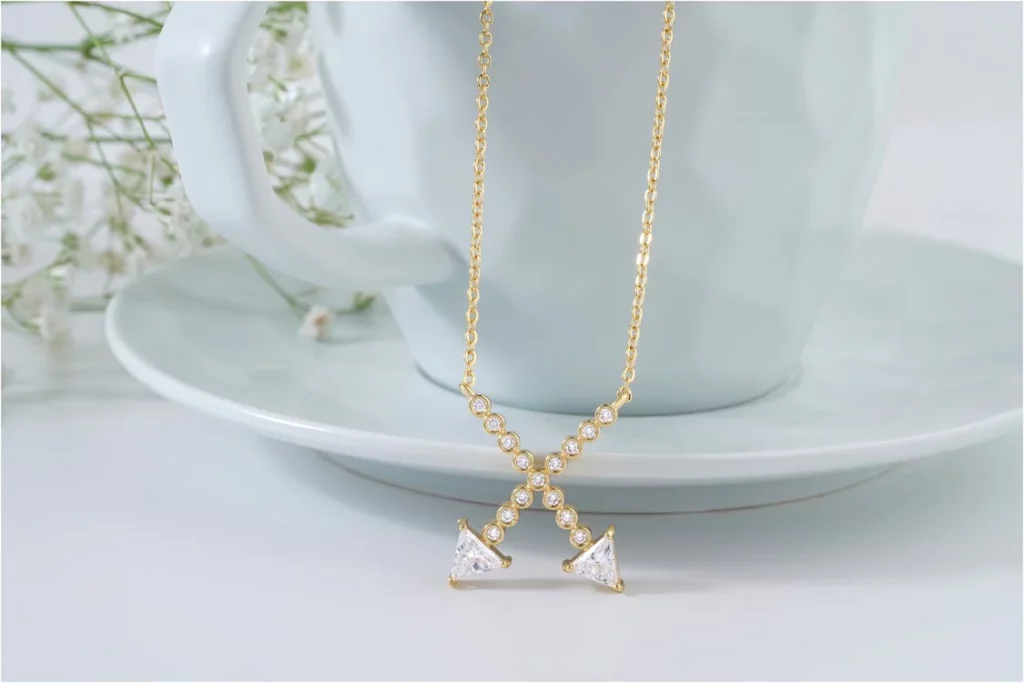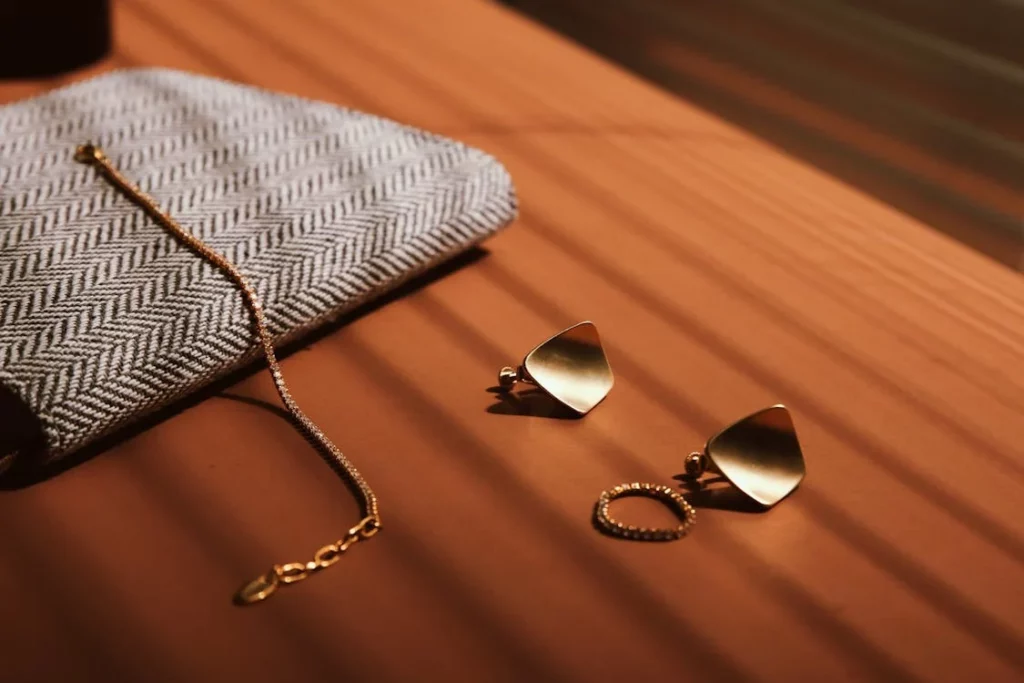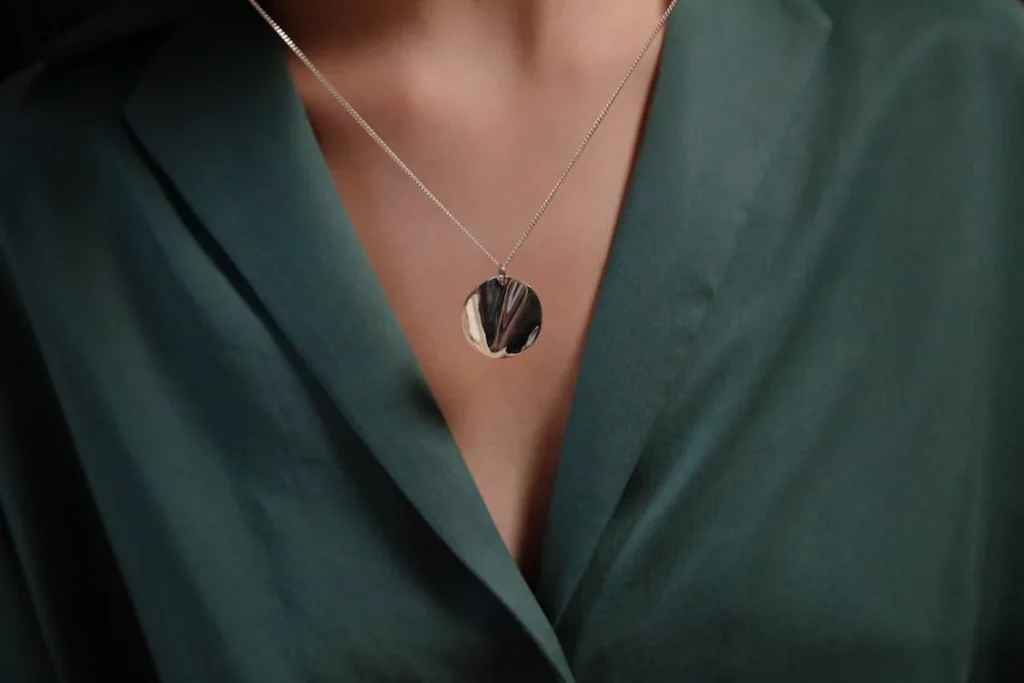¿Alguna vez te has preguntado qué implica la creación de esas impresionantes piezas de joyería de acero inoxidable que ves? Estos accesorios atemporales implican un proceso meticuloso que combina arte con tecnología avanzada. Comprender cómo se fabrican las joyas de acero te permitirá apreciar más profundamente la artesanía que hay detrás de cada pieza. Este artículo te lleva a un recorrido por la fábrica, donde te revela los secretos para transformar el acero inoxidable en bruto en joyas hermosas y duraderas. Desde el diseño hasta el pulido, cada paso es crucial para garantizar que el producto final sea tan cautivador como resistente.

Los conceptos básicos de la joyería de acero inoxidable
La joyería de acero inoxidable, también conocida como réplica de joyería de acero inoxidable, se ha vuelto popular gracias a sus propiedades únicas y atractivo estético. Los aspectos fundamentales de este material pueden aumentar su aprecio por estas exquisitas piezas. Analicemos qué hace que el acero inoxidable sea tan especial y por qué es una opción ideal para la joyería.
Elementos en acero inoxidable
El acero inoxidable es una aleación compuesta principalmente de hierro, carbono y cromo. Cada elemento desempeña un papel crucial en la definición de sus propiedades:
- Hierro (Fe)El hierro, el componente principal, confiere al acero inoxidable su resistencia y maleabilidad fundamentales. Forma la base sobre la que se añaden otros elementos.
- Carbono (C)Se añade carbono en pequeñas cantidades (hasta 1,21 TP3T) para aumentar la dureza y la resistencia. Esto permite el tratamiento térmico del acero, mejorando aún más sus propiedades mecánicas.
- Cromo (Cr)El cromo, presente típicamente en concentraciones de al menos 10,51 TP3T, es lo que le confiere al acero inoxidable su carácter "inoxidable". Reacciona con el oxígeno para formar una fina capa invisible de óxido de cromo sobre la superficie, lo que previene la corrosión y la oxidación. A mayor contenido de cromo, mayor resistencia a la corrosión.
- Níquel (Ni)El níquel, que suele añadirse para mejorar la tenacidad y la ductilidad, también contribuye a la resistencia a la corrosión de la aleación. Grados como el acero inoxidable 304 y 316 contienen cantidades significativas de níquel, lo que los hace más resistentes a la oxidación y la corrosión.
- Molibdeno (Mo)Presente en algunos aceros inoxidables, el molibdeno mejora la resistencia a la corrosión por picaduras y grietas, especialmente en entornos con cloruros. Esto lo hace ideal para aplicaciones marinas y condiciones altamente corrosivas.
- Titanio (Ti)El titanio, añadido ocasionalmente para estabilizar la estructura, previene la formación de carburos de cromo durante la soldadura. Esto contribuye a mantener la resistencia a la corrosión y mejora la resistencia general de la aleación.
- Manganeso (Mn):Utilizado para mejorar la resistencia y la tenacidad, el manganeso también ayuda a eliminar las impurezas de oxígeno y azufre del acero durante la producción.
- Silicio (Si):Añadido en pequeñas cantidades, el silicio aumenta la resistencia y también ayuda en el proceso de desoxidación durante la fabricación.
La combinación precisa de estos elementos determina el grado específico de acero inoxidable, cada uno diseñado para aplicaciones específicas. Para joyería, se suele preferir el acero inoxidable 316L debido a su superior resistencia a la corrosión, excelente durabilidad y propiedades hipoalergénicas. Este grado, a veces conocido como acero quirúrgico, mantiene un alto nivel de pulido y es menos propenso a causar irritación cutánea, lo que lo hace ideal para joyería corporal y piezas de uso diario.
¿Por qué el acero inoxidable es ideal para la joyería?

Varias características hacen del acero inoxidable una excelente opción para joyería. Aquí hay varias razones por las que se recomienda la joyería de acero inoxidable:
- DurabilidadEl acero inoxidable es muy resistente a arañazos, abolladuras y deformaciones, lo que lo hace perfecto para el uso diario.
- Resistencia a la corrosión:El contenido de cromo en el acero inoxidable forma una capa protectora que evita la oxidación y el deslustre incluso cuando se expone a la humedad y al aire.
- Hipoalergénico:El acero inoxidable es adecuado para personas con piel sensible, ya que es poco probable que provoque reacciones alérgicas o irritación.
- Bajo mantenimientoA diferencia de otros metales que requieren pulido frecuente, el acero inoxidable conserva su brillo con un mínimo cuidado. Una limpieza ocasional es suficiente para mantenerlo impecable.
- AsequibilidadEl acero inoxidable ofrece una alternativa rentable a los metales preciosos como el oro y el platino, proporcionando una apariencia lujosa a una fracción del precio.
- Versatilidad en el diseño:Su resistencia permite realizar detalles intrincados y diversos acabados, desde el alto pulido hasta el mate, posibilitando la creación de piezas de joyería tanto clásicas como contemporáneas.
- Respetuoso con el medio ambienteEl acero inoxidable 100% es reciclable, lo que lo convierte en una opción sustentable para los consumidores conscientes del medio ambiente.
- No reactivo:No reacciona con aceites corporales, lociones u otras sustancias, lo que garantiza que la joyería conserve su apariencia y no se decolore con el tiempo.
¿Cómo hacer joyas de acero inoxidable? Tutorial

En una fábrica de joyas de acero inoxidableEl proceso de creación combina tecnología sofisticada y artesanía experta. Cada paso, desde el diseño inicial hasta el pulido final, es crucial para producir joyas hermosas y duraderas. Aquí te mostramos un proceso paso a paso sobre cómo fabricar joyas de acero inoxidable, garantizando que cada pieza cumpla con los más altos estándares de calidad.
Diseño

El diseño es el primer y más importante paso en la creación de joyas de acero inoxidable. El proceso comienza con la conceptualización del diseño, que implica el boceto y el detalle de la pieza de joyería deseada. Con el software CAD (Diseño Asistido por Computadora), fabricantes de joyas de acero inoxidable personalizadas Permite crear modelos 3D complejos. Esto permite precisión y realizar modificaciones fácilmente.
- Nota: Es esencial prestar mucha atención a las proporciones y los detalles en esta etapa.
Selección de materia prima
El acero inoxidable se suele suministrar en láminas o barras, que luego se cortan a medida según las especificaciones del diseño. Para joyería, se suele preferir el acero inoxidable 316L debido a sus características superiores. Resistente a la corrosión, impermeable, antideslustre e hipoalergénico. Propiedades. Este grado, también conocido como acero quirúrgico, garantiza la durabilidad y seguridad de las joyas para todo tipo de piel. Al seleccionar las materias primas, asegúrese de que provengan de proveedores de confianza para garantizar la calidad.
Cortar el acero inoxidable
El siguiente paso consiste en cortar el acero inoxidable en las formas y tamaños requeridos. La precisión es clave. Se emplean técnicas avanzadas como el corte por láser o el mecanizado CNC (Control Numérico Computarizado).
- Corte por láser Ofrece precisión, permitiendo diseños intrincados sin comprometer la integridad del material.
- Mecanizado CNC garantiza uniformidad y precisión, lo cual es esencial para crear piezas consistentes, especialmente en producciones al por mayor de réplicas de joyas de acero inoxidable de gran tamaño.
Dar forma y moldear
Tras el corte, las piezas de acero inoxidable se moldean. Esto implica doblar, martillar y moldear el metal para lograr los contornos y las estructuras deseados. Los artesanos expertos utilizan diversas herramientas, como yunques, mandriles y martillos especializados. Además, se pueden emplear prensas hidráulicas y laminadores para formas más complejas, garantizando así uniformidad y precisión. Se debe tener cuidado de no trabajar el metal en exceso, ya que puede causar fracturas por tensión o debilitar la estructura.
- Nota: Al doblar, martillar y moldear, debe prestar atención a las siguientes situaciones y peligros:
Doblado:
- Los materiales más gruesos requieren más fuerza para doblarse, lo que puede provocar fracturas por tensión si no se hace correctamente.
- El radio de curvatura no es demasiado estrecho, ya que puede causar grietas a lo largo de la curva. Un radio mayor puede ayudar a distribuir la tensión de forma más uniforme.
- El acero inoxidable tiende a recuperarse ligeramente después de doblarse. Un ligero sobredoblado puede compensar esto, asegurando así la forma final deseada.
Martillo:
- Un mazo de cuero crudo o de goma es ideal para dar forma sin dañar la superficie, mientras que se puede utilizar un martillo de acero para trabajos más detallados.
- Para evitar dañar la superficie, coloque una capa protectora (como una almohadilla de cuero o goma) entre el metal y el yunque.
- El martillado puede endurecer el metal, volviéndolo frágil. Es importante recocerlo (calentarlo y enfriarlo) periódicamente para restaurar su ductilidad.
Moldura:
- El moldeo a veces requiere calor para que el metal sea más flexible. Evite el sobrecalentamiento, ya que puede debilitarlo.
- El diseño del molde debe tener en cuenta la contracción y expansión del metal durante el proceso de enfriamiento.
- El diseño del molde evita esquinas afiladas o secciones delgadas que pueden crear concentraciones de tensión, lo que puede provocar fracturas o puntos débiles.
Soldadura

La soldadura es un paso fundamental en el ensamblaje de joyas. Este proceso implica unir diferentes componentes con un metal de aporte con un punto de fusión más bajo. Se utilizan sopletes de alta temperatura para fundir la soldadura, creando uniones resistentes y sin fisuras. Además, la precisión es fundamental, ya que una soldadura incorrecta puede debilitar la estructura. También es importante utilizar el tipo correcto de soldadura para acero inoxidable a fin de evitar problemas de corrosión posteriores.
- Soldadura de plata
- ComposiciónLa soldadura de plata, también conocida como soldadura de argentium, suele contener plata, cobre y una pequeña cantidad de otros metales. Es altamente compatible con el acero inoxidable gracias a sus propiedades térmicas y punto de fusión similares.
- TiposLa soldadura de plata se presenta en varios grados, incluyendo duro, medio y fácil. Para el acero inoxidable, se suele preferir el grado medio o fácil, ya que tiene un punto de fusión más bajo y es menos probable que afecte la integridad del acero inoxidable.
- VentajasLa soldadura de plata proporciona uniones resistentes y duraderas, y se asemeja al acero inoxidable, lo que ayuda a mantener una apariencia uniforme. Además, ofrece una excelente resistencia a la corrosión y al deslustre.
- Soldadura de acero inoxidable
- ComposiciónLa soldadura de acero inoxidable está diseñada específicamente para igualar las propiedades del acero inoxidable, y suele contener una mezcla de polvo y fundente de acero inoxidable. Está formulada para funcionar con acero inoxidable sin comprometer su resistencia a la corrosión.
- TiposDisponible en diversas formulaciones, incluyendo aquellas con diferentes puntos de fusión para adaptarse a diversas aplicaciones. La soldadura de acero inoxidable se utiliza generalmente en entornos profesionales o de alta precisión.
- VentajasGarantiza la compatibilidad con el acero inoxidable y mantiene la resistencia a la corrosión del material. Es ideal para la joyería profesional de alta calidad.
- Flujo
- ComposiciónEl fundente se utiliza junto con la soldadura para limpiar las superficies metálicas y facilitar su flujo. Para acero inoxidable, se recomienda usar un fundente específicamente formulado para este material.
- TiposLos fundentes más comunes incluyen los fundentes a base de colofonia y los fundentes a base de ácido. El fundente a base de ácido es eficaz para el acero inoxidable, pero debe limpiarse a fondo después de soldar para evitar la posible corrosión.
- Ventajas:Un fundente adecuado ayuda a garantizar una unión limpia entre la soldadura y el acero inoxidable, lo que da como resultado una unión más fuerte.
Limado y lijado
Tras la soldadura, las piezas de joyería requieren un limado y lijado meticuloso para suavizar las asperezas y eliminar el exceso de soldadura. Se utilizan limas y lijas de diferentes grados, de grueso a fino, para refinar gradualmente la superficie. Este paso es crucial para lograr un acabado pulido. Además, es importante trabajar sistemáticamente y revisar el progreso con frecuencia para asegurar una superficie uniforme.
- Nota: Se debe utilizar ventilación adecuada y equipo de protección para evitar inhalar polvo metálico.
Pulido

Pulir las joyas de acero inoxidable es un paso fundamental que realza su atractivo visual y suavidad. A continuación, te explicamos cómo abordar el proceso de pulido y qué debes tener en cuenta:
- Limpieza inicial: Antes de pulir, asegúrese de limpiar bien la joya para eliminar cualquier residuo, polvo o suciedad de etapas anteriores. Esto puede hacerse con limpiadores ultrasónicos o soluciones de limpieza suaves.
- Ruedas de pulido: Puede usar discos de pulido instalados en una pulidora. Comience con un disco más grueso y vaya usando gradualmente discos más finos. Este método ayuda a eliminar rayones y logra una superficie lisa.
- Compuestos de pulido: Puede aplicar compuestos de pulido adecuados, como pulimento para metales, a las ruedas de pulido. Luego, aplíquelo uniformemente y compáctelo uniformemente sobre el metal.
- Técnicas: Puede usar un movimiento suave y constante al pulir. Evite presionar con demasiada fuerza la joya, ya que esto puede causar un pulido desigual o distorsionar su forma.
Nota: El pulido genera calor, lo cual puede afectar las propiedades del metal. Evite el sobrecalentamiento puliendo de forma intermitente y dejando que la joya se enfríe si es necesario.
Toques finales

La etapa final consiste en añadir cualquier elemento adicional que complete la joya. Esto puede incluir el engaste de gemas, la aplicación de grabados o la adición de capas protectoras. Los toques finales aportan personalidad y singularidad a cada pieza, convirtiéndola en una verdadera obra de arte. Los controles de calidad son esenciales en esta etapa para garantizar que cada pieza cumpla con las especificaciones y estándares deseados.
¿Cómo hacer que las joyas de acero inoxidable brillen? Consejos fáciles
Conseguir un brillo radiante en las joyas de acero inoxidable realza su atractivo visual y garantiza un aspecto pulido y profesional. Aquí tienes algunos consejos sencillos para que tus joyas de acero inoxidable brillen:
- Limpie sus joyas de acero inoxidable regularmente con una solución de jabón suave y un paño suave diseñado para acero inoxidable para eliminar la suciedad, los aceites, el deslustre y los residuos que pueden opacar su brillo.
- Para un brillo más profundo, aplique un compuesto de pulido específico para acero inoxidable con un paño suave o una rueda de pulido para lograr un acabado de alto brillo.
- Evite utilizar productos químicos agresivos o materiales abrasivos que puedan rayar o opacar la superficie de sus joyas de acero inoxidable.
- Para diseños intrincados, utilice un cepillo de cerdas suaves para llegar a espacios reducidos y asegurarse de que cada parte de la joyería esté limpia y pulida de manera uniforme.
- Después de limpiar y pulir, seque bien la joyería con un paño sin pelusa para evitar manchas de agua y mantener su brillo.
- Guarde sus joyas en un lugar seco y limpio, y utilice bolsas o paños antideslustre para protegerlas del deslustre y mantener su brillo intacto.
¿Qué tan duraderas son las joyas de acero inoxidable?
Es altamente resistente a rayones, deslustre y corrosión, lo que lo convierte en una excelente opción para el uso diario. Su robustez garantiza que mantenga su forma y apariencia con el tiempo, incluso con un uso regular. A diferencia de otros metales, el acero inoxidable no se dobla ni deforma fácilmente, ofreciendo una resistencia y fiabilidad duraderas.
¿Cuánto duran las joyas de acero inoxidable?
Las joyas de acero inoxidable están diseñadas para una larga duración, que suele durar varias décadas o incluso toda la vida con el cuidado adecuado. A diferencia de los metales preciosos, que pueden requerir pulido o rechapado frecuente, el acero inoxidable conserva su brillo e integridad estructural con un mantenimiento mínimo. Factores como la exposición a productos químicos agresivos y el desgaste físico pueden afectar su vida útil, pero, en general, las joyas de acero inoxidable siguen siendo una opción atemporal y duradera.
Conclusión
El arte de crear joyería de acero exhibe una perfecta armonía de habilidad, precisión y creatividad. Cada pieza, desde su diseño inicial hasta el pulido final, cuenta una historia de dedicación artesanal. La joyería de acero inoxidable es testimonio de belleza y robustez duraderas, ofreciendo una elegancia atemporal con un mantenimiento mínimo. Al adornarse con estas exquisitas piezas, lleva consigo el legado de la maestría artesanal y la extraordinaria trayectoria del acero transformado en arte.







